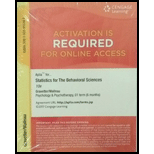
Concept explainers
15. In Example 11.2 (p. 343) we presented a repeated measures research study demonstrating that swearing can help reduce ratings of pain (Stephens, Atkins, & Kingston, 2009). In the study, each participant was asked to plunge a hand into icy water and keep it there as long as the pain would allow. In one condition, the participants repeated their favorite curse words while their hands were in the water. In the other condition, the participant repeated a neutral word. Each participant rated the intensity of the pain on a 10-point scale. Of the n = 25 participants 17 had a lower pain rating When swearing, 6 had a higher rating, and 2 showed no difference between the two conditions. Is this result significantly different from what would be expected by chance? Use a two-tailed test with a = .05.
EXAMPLE 11.2Swearing is a common, almost ref1exive, response to pain. Whether you knock your shin into the edge of a coffee table or smash your thumb with a hammer, most of us respond with a streak of obscenities. One question, however, is whether swearing focuses attention on the pain and, thereby, increases its intensity, or serves as a distraction that reduces pain. To address this issue, Step hens, Atkins and Kingston (2009) conducted an experiment comparing swearing with other responses to pain. In the study, participants were asked to place one hand in icy cold water for as long as they could bear the pain. Half of the participants were told to repeat their favorite swear word over and over for as long as their hands were in the water. The other half repeated a neutral word. The participants rated the intensity of the pain and the researchers recorded how long each participant was able to tolerate the ice water. After a brief rest, the two groups switched words and repeated the ice water plunge. Thus, all the participants experienced both conditions, (swearing and neutral) with half swearing on their first plunge and half on their second. The results dearly showed that swearing significantly increased pain tolerance and decreased the perceived level of pain. The data in Table 11.3 are representative of the results obtained in the study and represented the reports of pain level of n = 9 participants.
If the result is significantly different from chance using a two-tailed test with
Answer to Problem 15P
Solution:
Since np and nq = 12.5 >10 so using the Binomial test and Z scores is valid with
Explanation of Solution
Given:
In a study (Stephens, Atkins, & Kingston, 2009) study showing that swearing can help relieve pain, participants placed one hand in freezing cold water for as long as they could bear the pain. In one condition, they shouted a swear word over and over while the hand was in the water. In the other condition, they shouted a neutral word. Each participant rated intensity of pain on a 10 point scale. Suppose out of n=25 participants 17 had lower pain rating, 6 had higher, 2 showed no difference in condition.
Calculations:
The null hypothesis states that for all the 3 ratings the population proportion is 0.5, hence
For this X = 17, 6 and 2, n=25, the sample proportion
Conclusion:
We reject
Justification:
Reject
Want to see more full solutions like this?
Chapter 18 Solutions
Statistics for Behavior Sciences - LMS MindTap
 Glencoe Algebra 1, Student Edition, 9780079039897...AlgebraISBN:9780079039897Author:CarterPublisher:McGraw Hill
Glencoe Algebra 1, Student Edition, 9780079039897...AlgebraISBN:9780079039897Author:CarterPublisher:McGraw Hill Holt Mcdougal Larson Pre-algebra: Student Edition...AlgebraISBN:9780547587776Author:HOLT MCDOUGALPublisher:HOLT MCDOUGAL
Holt Mcdougal Larson Pre-algebra: Student Edition...AlgebraISBN:9780547587776Author:HOLT MCDOUGALPublisher:HOLT MCDOUGAL

